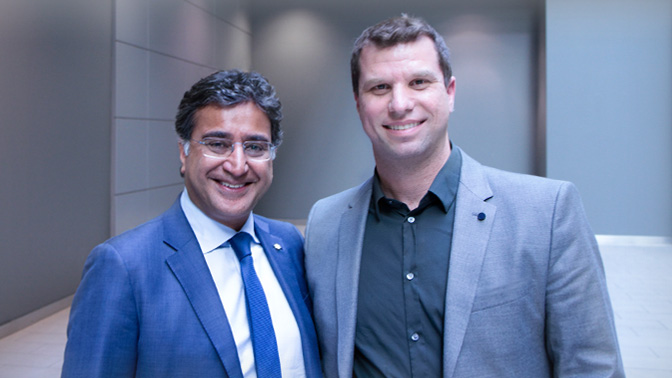
Drs. Shaf Keshavjee and Marcelo Cypel, joint winners of UHN’s Inventor of the Year (Photo credit: UHN StRiDe Team).
Dr. Shaf Keshavjee, Surgeon-in-Chief in the Sprott Department of Surgery at UHN and Director of the Toronto Lung Transplant Program and Dr. Marcelo Cypel, Surgical Director of the UHN Transplant Program, have been recognized as the joint winners of UHN’s 2018 Inventor of the Year by the UHN Technology Development & Commercialization Office (TDC).
Each year, UHN’s TDC celebrates a UHN inventor or inventors who illustrate noteworthy excellence through inventiveness in research, critical contributions and commercial successes impacting patients and their quality of life.
Drs. Keshavjee and Cypel are internationally recognized lung transplant surgeons at UHN – one of the top ranked organ transplant centres in North America and the number one lung transplant centre worldwide.
They are being honoured for development of the Toronto Ex Vivo Lung Perfusion System, a landmark advance in lung transplantation, which has helped to increase the availability of donor lungs here and around the world. Their work was directly funded by Toronto General & Western Hospital Foundation donors.
Addressing a shortage of viable donor lungs
Lung transplantation is the only life-saving therapy for patients with end-stage lung disease. Unfortunately, there are significant mortality rates on lung transplant waiting lists, up to 16 per cent per year for some diagnoses. The greatest challenge remains a shortage of clinically acceptable donor organs for transplantation – up to 80 per cent of donor lungs are discarded due to suspected injury.
To overcome this challenge, Drs. Keshavjee and Cypel created the Ex Vivo System.
Using the Ex Vivo System, donated lungs are placed in a sterile chamber, oxygenated and provided nutrition for an extended period of time. The protective system enables the transplant team to assess the lung and, if required, treat it with medication or sophisticated therapies such as gene therapy or cell therapy, thereby rehabilitating injured lungs and further increasing the donor lung pool.
This means that lungs that previously may have been discarded can now be repaired for a successful transplant. Surgeons can also determine how the lungs will function before they are transplanted, further improving patient outcomes.
Having global impact
The Ex Vivo System is now in use at transplant centres around the world, including Duke, Johns Hopkins and the Mayo Clinic. More than 550 clinical cases in Toronto, and many more internationally, have been performed using Ex Vivo, resulting in thousands of lives saved for patients with end stage lung diseases. Use of the system at UHN has accounted for an increase in donor lung utilization of 15 to 20 per cent, doubling the number of lung transplants performed each year.
Teams at UHN have since translated Ex Vivo technology to other organs, including the kidneys, liver and, soon, heart.
Drs. Keshavjee and Cypel have served as passionate advocates for Ex Vivo perfusion and organ transplantation. The inventors believe Ex Vivo technology will substantially address the global shortage of donor lungs and help significantly reduce, if not eliminate, lung transplant wait times – saving many lives in years to come.


